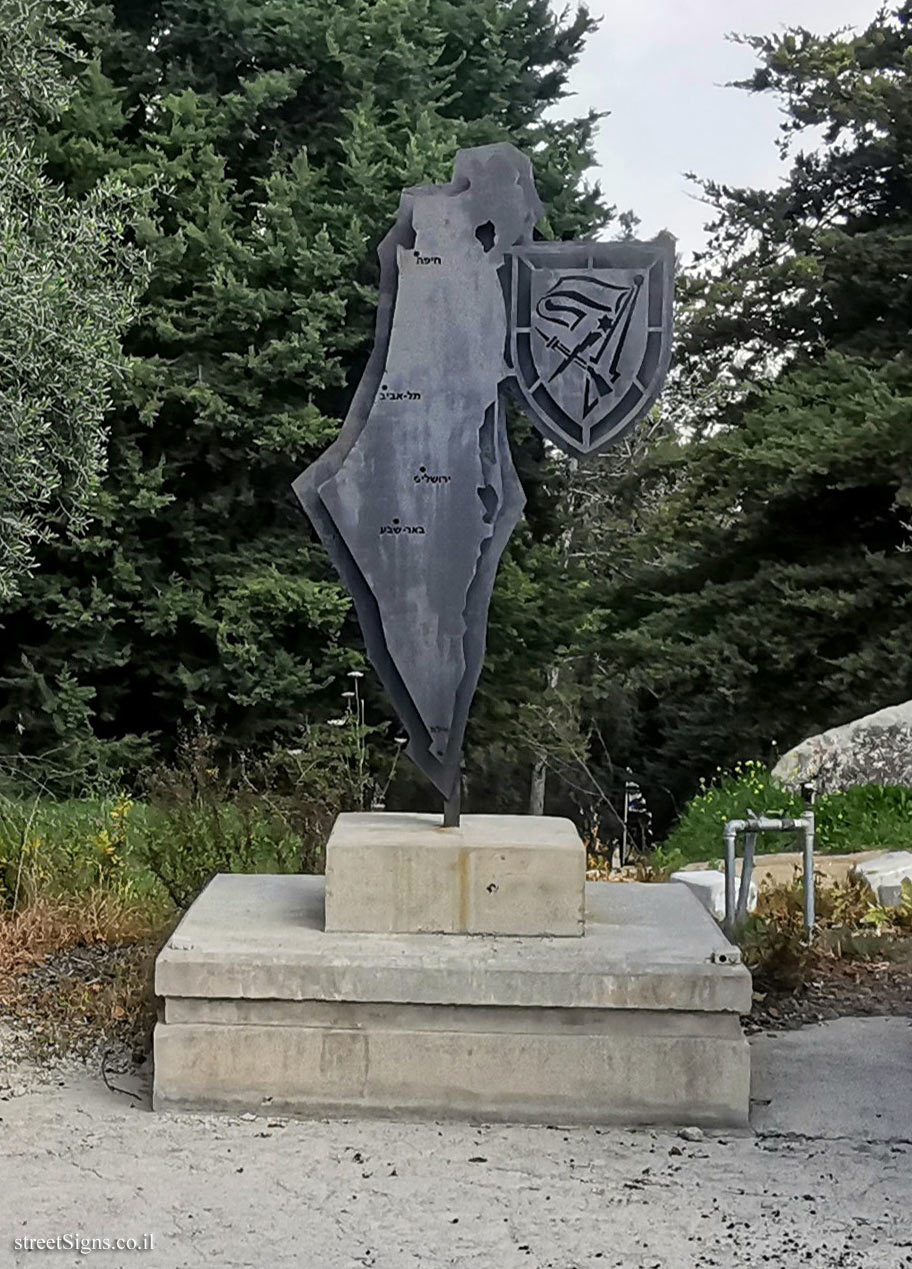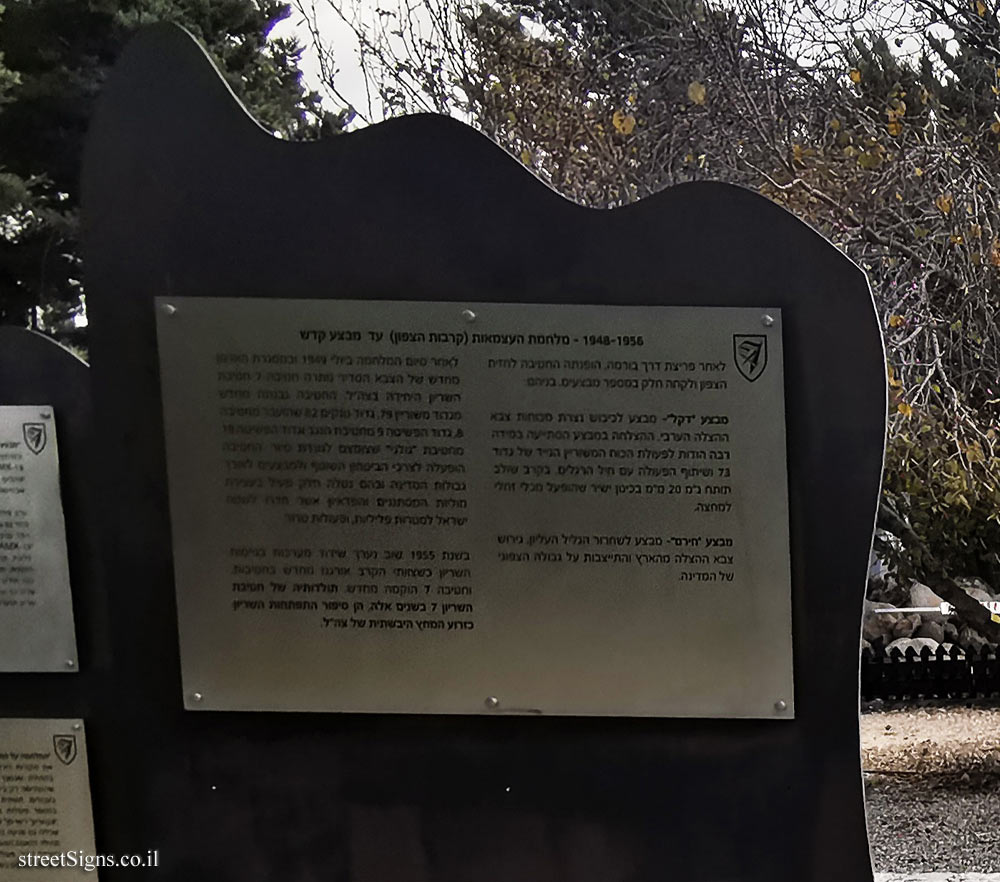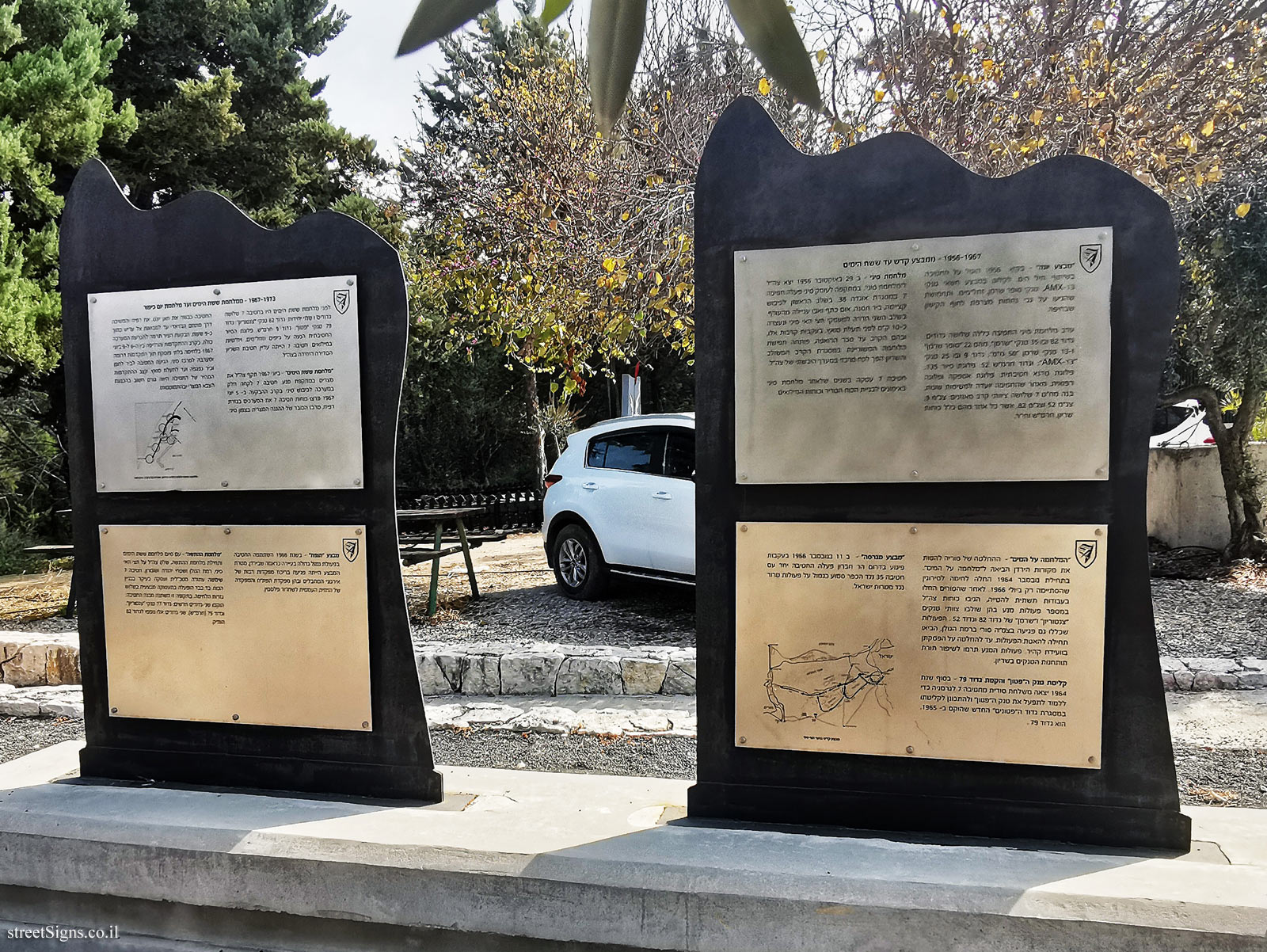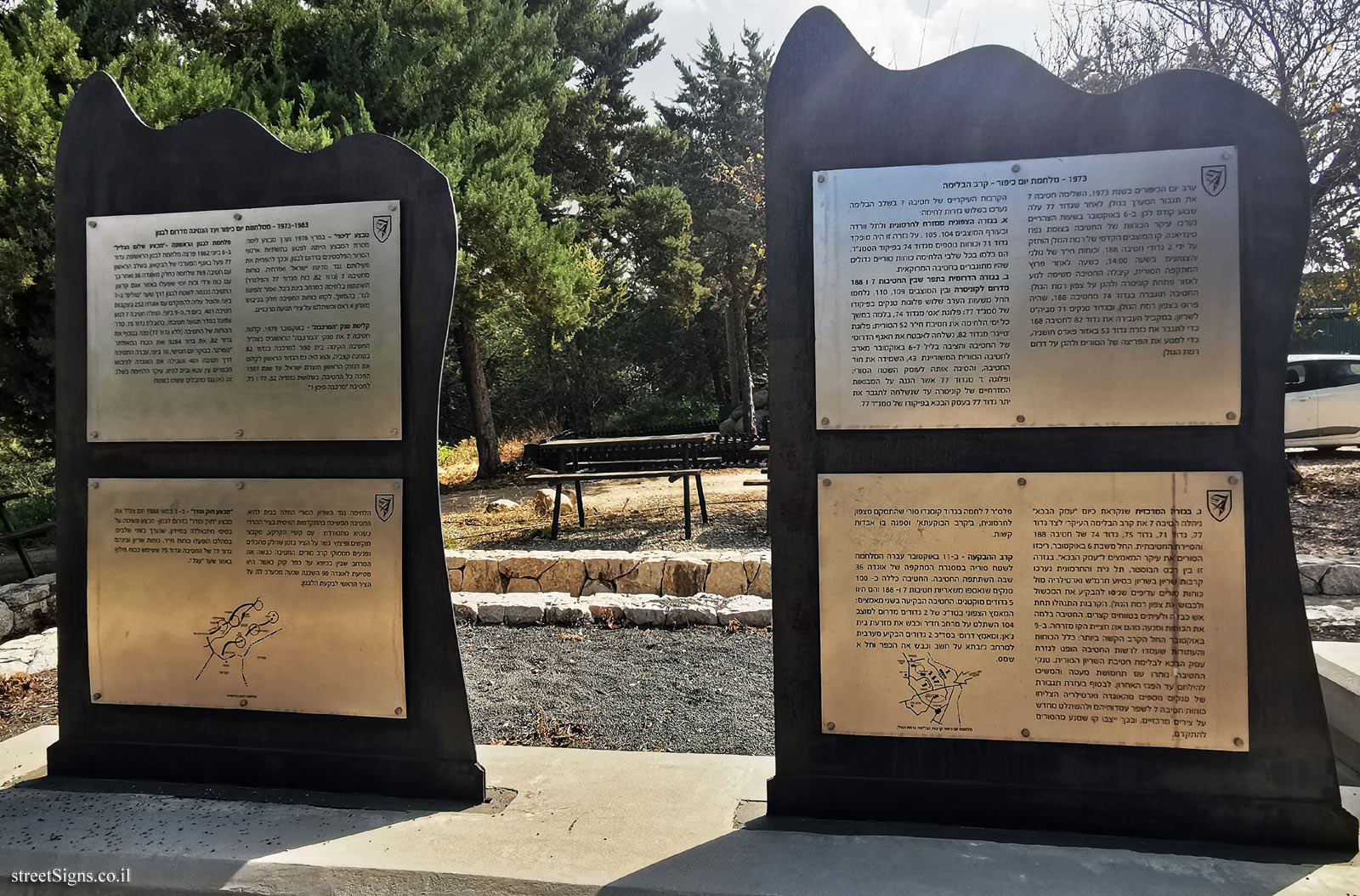The monument with the map of Israel and the emblem of the 7th Brigade was photographed by the same photographer that day
 Click for a larger image
Click for a larger image The rest of the plaques were taken by the same photographer that day
Plaque 3
 Click for a larger image
Click for a larger image Plaques 4-7
 Click for a larger image
Click for a larger image Plaques 8-11
 Click for a larger image Translation of the text on the sign
Click for a larger image Translation of the text on the sign:
The 7th Brigade badge
Establishment of the Brigade, from the War of Independence Battles of Latrun With the declaration of the establishment of the state on May 14, 1948 and the invasion of the regular Arab armies. The Prime Minister and Defense Minister David Ben-Gurion instructed the IDF to establish the first armored brigade called the "Reserve Brigade", which is the 7th Brigade. Infantry Battalions, 71, 72nd and 73rd Armored Battalion, with 2 armored companies and a Half-track company. In the same week about one thousand nine hundred fighters were absorbed into the brigade.
"Operation Ben Nun" A - was the first operation in which the 7th Brigade took part in the War of Independence. On May 22, Ben-Gurion ordered the operation of the 7th Brigade to open the road to detached Jerusalem. Its first tasks were to reach Ma’ale Hahamisha and move a convoy to Jerusalem, to join the Etzioni and Harel brigades in order to facilitate and protect the Jerusalem area. On May 25, at midnight, the brigade was involved in a difficult encounter with dug-up Legion forces in the control areas of the Latrun area. The brigade was repulsed and retreated in a difficult battle to escape to the assembly areas.
[Plaque 2]
Operation "Ben Nun B"- Only five days after the battle, the brigade was again tasked with attacking the Latrun ridge, occupying the monastery and the police compound. It was the first armored battle of the 7th Brigade in which the armored personnel carriers of the 73rd Battalion took part together with the infantry forces (including the 52nd Battalion of the Givati Brigade). Even in this attack the brigade failed to capture Latrun.
During the difficult battles over the Latrun area, an alternative route to besieged Jerusalem was found, and its preparation became the brigade’s main mission. This road is the "Burma Road". The division determined the final route of the road. For 8 days and nights, the brigade managed, and secured in conjunction with civil mechanical engineering equipment, the break-in and paving of the road, which was initially called the "7th Brigade Road."
[Plaque 3]
1948-1955 - War of Independence (Battles of the North) until Operation Kadesh Following the breakthrough of the "Burma Road", the brigade was directed to the northern front and took part in a number of operations, including:
Operation Dekel - Operation to occupy Nazareth from the forces of the Arab Rescue Army. The success of the operation was largely aided by the action of the 73rd Battalion’s mobile armored force and the cooperation with the infantry. In the battle a 20mm anti-aircraft cannon was incorporated as a direct set-up operated from semi-caterpillar vessels.
Operation "Hiram" - an operation to liberate the Upper Galilee, expel the rescue army from the country and stabilize on the northern border of the country.
After the end of the war in July 1949 and as part of the reorganization of the regular army, the 7th Brigade remained the only armored brigade in the IDF. The brigade was rebuilt from the 79th Armored Battalion, the 82nd Tank Battalion transferred from the 8th Brigade, the 9th Battalion from the Negev Brigade and the 19th Battalion from the Golani Brigade, which was reduced to a patrol. The brigade was activated for the ongoing security needs and for operations along the country’s borders, in which it took an active part in stopping the infiltrators’ squads and the infantry, which infiltrated Israeli territory for criminal purposes and terrorist acts.
In 1955, the Armored Forces were reorganized again as the battle teams were reorganized into brigades, and the 7th Brigade was re-established. The history of the 7th Armored Brigade during these years is the story of the development of the Armored Corps as the IDF’s ground arm.
[Plaque 4]
1956-1967 - From the Suez Crisis to the six days war "Operation Yonah" - In the summer of 1956, the brigade, in cooperation with the Navy, was secretly assigned to receive AMX-13 tanks, Super Sherman tanks, Half-tracks, and ammunition that arrived on land from France to the Kishon coast in Haifa.
On the eve of the Sinai War the brigade included three battalions, the 82nd Battalion with 35 "Sherman" tanks of which 22 were "Super Sherman" and 13 Sherman "50mm" tanks, 9th Battalion with 25 "AMX-13" tanks and 52nd Armored Infantry Regiment, 135th Reconnaissance Company, Brigade Workshop Flood, Supply Company and Medical Company. Since the brigade was intended for various missions, the commander of the 7th Brigade built three balanced battle crews: 9th, 2nd 52nd and 82nd 82, each of which included armored forces, an armored infantry and an infantry.
[Plaque 5]
"The war on water" - Syria’s decision to divert the sources of the Jordan has led to a "war on water". In early November 1964, intermittent fighting began, ending only in July 1966. After the Syrians began diversionary infrastructure work, IDF forces responded with a number of preventive actions involving the Centurion and Sherman tank teams of the 82nd Battalion and 52nd Battalion. The operations, which also included damage to Syrian mechanical engineering equipment in the Golan Heights, initially slowed down operations, until a decision was made to stop them at the Cairo conference. The preventive actions contributed to the improvement of the theory of tank artillery in the armor.
Absorption of the "Patton" tank and establishment of the 75th Battalion - At the end of 1964, a secret delegation from the 7th Brigade left for Germany to learn how to operate the Patton tank and prepare for its absorption as part of the new Patton Battalion established in 1965, the 79th Battalion.
Operation Shredder - On November 11, 1966, following an attack in the southern Hebron Mountains, the brigade, together with the 35th Brigade, acted against the village of Samua in retaliation for terrorist acts against Israeli targets.
Sinai War On October 29, 1956, the IDF launched the Sinai War.
In the attack to the depths of Sinai, the 7th Brigade operated within the 38th Division. In the first phase of the occupation of Katsima, Bir Hassana, Umm Kataf and Abu Agila from the rear. In the second phase, it penetrated to the depths of the Sinai Peninsula and stopped about 10 km before the Suez Canal.
Following these battles, including the battle for the Ruifa Dam, the concept of armored warfare was developed as part of the combined battle, and armor became a major force in the IDF’s ground formation.
In the years following the Sinai War, the 7th Brigade engaged in training to build the regular force and the reserve forces.
[Plaque 6]
1967-1973 - From the Six Day War to the Yom Kippur War Before the Six Day War, the 7th Brigade had three battalions and two units. 82nd Centurion Battalion, 79th Patton Battalion, 9th Armored Infantry Regiment, Brigade Reconnaissance Company moving on jeeps and half-tracks. And a unit in reserve. The 7th Brigade was still the only regular armored brigade in the IDF.
"Six Day War" - In June 1967, the IDF attacked Egypt with a preemptive strike. Brigade 7 took part in the campaign to occupy Sinai. During the rift on June 5, 1967, Brigade 7 forces broke into the battles in the Rafah sector, the center of gravity Of the Egyptian defense in northern Sinai. The brigade captured Khan Yunis, Rafah and continued through the Jirdi compound to the entrances to Arish within about 9 hours.The breakdown of the axis contributed to the decision of the entire campaign, among the advance and persecution between 6 and 9 June 1967 In incessant fighting as it advanced south and west to central Sinai, the brigade reached Bir Hama and Bir Gafgafa as far as the Suez Canal, and the brigade’s rapid pace of progress was an important factor in the submission and collapse of the Egyptian army.
[Plaque 7]
Operation "Inferno" - In 1968, the brigade participated in a large retaliatory operation in the town of Karama in Jordan. The purpose of the operation was to harm the concentration of many headquarters of the terrorist organizations, including the Fatah headquarters and the headquarters of the Popular Front for the Liberation of Palestine.
"War of Attrition" - At the end of the Six Day War and the beginning of the War of Attrition, the IDF controlled the Sinai Peninsula, the Golan Heights and the territories of Judea and Samaria. The 7th Brigade served as a General Staff reserve and dealt mainly with the power building. At the same time it was also engaged in operational employment in the three combat sectors. During this period, the brigade’s structure changed: two new battalions were established: the 77th Century Battalion, and the 75th Battalion (Armored Infantry). These two battalions were added to the old 82nd Battalion.
[Plaque 8]
1973 - Yom Kippur War - The Containment Battle On the eve of Yom Kippur in 1973, the 7th Brigade completed the reinforcement of the line in the Golan. After the 77th Battalion ascended to the Golan Heights a week earlier. On the afternoon of October 6, most of the brigade’s forces were held at the Cindiana Napha Junction. The front line of the Golan Heights was held by 2 battalions of the 188th Brigade, and infantry forces of the Golani and the paratroopers. At 14:00, about an hour after the outbreak of the Syrian attack, the brigade was given a mission to move to the area of the opening of Quneitra and defend the northern Golan Heights. The brigade was reinforced in the 74th Battalion of the 188th Brigade, which was deployed in the northern Golan Heights, and in the 71st Tank Battalion from the Armored School. At the same time, it transferred the 82nd Battalion to the 188th Brigade to reinforce the sector of the 53rd Battalion in the Fares Hoshenya area, to prevent the Syrian invasion and to defend the southern Golan Heights.
The main battles of the 7th Brigade in the containment phase were fought in three combat sectors:
A. In the northern sector east of Hermonit and Tel Verde and at the rear of outposts 104, 105. This sector was commanded by the 71st Battalion and other forces from the 74th Battalion under the command of the battalion’s deputy commander. They halted at all stages of the fighting large Syrian forces that were reinforced in the Moroccan brigade.
B. In the southern sector at the seam between the 7th and 188th Brigades south of Quneitra and the outposts 109 and 110, three tank companies under the command of the 77th Battalion’s deputy commander had been fighting since the evening hours:
An As company from the 74th Battalion, stopped the Syrian 52nd Infantry Brigade throughout the fighting;
The Tiger Company of the 82nd Battalion, was sent to secure the southern wing of the brigade and on the night of October 6-7 placed an ambush for the 43rd Armored Syrian Brigade, destroyed the brigade’s brigade, and retreated to the depths of Syrian territory; Company G of the 77th Battalion which defended the eastern entrances of Quneitra until it was sent to reinforce the rest of the 77th Battalion in the Valley of Weeping under the command of the 77th Battalion Deputy Commander.
[Plaque 9]
C. In the central sector now called the "Valley of Tears" the 7th Brigade conducted the main containment battle alongside the 77th Battalion, 71st Battalion, 75th Battalion, 74th Battalion of the 188th Brigade and the Brigade’s special forces. Starting on Saturday, October 6, the Syrians concentrated most of their efforts on the "Valley of Tears". In this sector between the Booster ridge, Tel Jit and Mount Hermon, armored battles were fought with the help of an armored infantry and artillery against superior Syrian forces that tried to score the barrier and conquer the northern Golan Heights. The battles were fought under heavy fire and sometimes at short range. The brigade halted the forces and prevented them from crossing the line to the east. On October 9, the most difficult battle began: All the forces and reserves available to the brigade were directed to the Valley of Tears to contain the Syrian Armored Brigade. The brigade tanks were left with low ammunition and continued to fight until the last shell. Finally, with the reinforcement of additional tanks from the division and artillery, the 7th Brigade forces were able to improve their positions and retake key axes, thus stabilizing a line that prevented the Syrians from advancing.
Reconnaissance Company 7 fought a Syrian commando battalion located north of Mount Hermon, in the Battle of the Buqata, and suffered heavy casualties.
The Battle of the Break-In - On October 11, the war moved to Syrian territory as part of the 36th Division attack in which the brigade participated. The brigade included about 100 tanks collected from the remnants of the 7th and 188th Brigades and they constituted 5 smaller battalions. The brigade concentrated on two efforts: the northern effort in the order of force of 2 battalions south of Post 104 took control of the Hadar area and captured Mizrat bin Jan; And a southern effort in the order of force of 2 battalions broke west to the "Jubta al-Hashav" area: and captured the village and Tel a-Shams.
[Plaque 10]
1973-1983 - From the Yom Kippur War to the withdrawal from southern Lebanon Operation Litani - In March 1978, Operation Litani was conducted. The purpose of the operation was to damage the infrastructure of Palestinian terrorist organizations in southern Lebanon, thereby reducing their activity against the State of Israel and its citizens. Forces from the 7th Brigade (82nd Battalion, a force from the 77th Battalion and the special forces Squadron) took part in the fighting in the Bynet Jabal area and the Fatah Land area. Subsequently, the brigade’s forces took part in the occupation of Maroun a Ras and took control of major roads.
Absorption of the "Merkava" tank - In October 1979, the 7th Brigade absorbed the first "Merkava" tanks in the IDF.
The brigade established a "Merkava" tank school in the 82nd Battalion in the Katsavia camp, and it was also the first battalion to receive the first tank made in Israel. By 1981, the entire brigade, in its three 52nd, 77th and 75th Battalions, had become a "Mark 1 Chariot" brigade.
The First Lebanon War - "Operation Peace of the Galilee" - On June 6, 1982, the First Lebanon War broke out. The 77th Battalion operated in the western wing of the Bekaa. In the first phase with the 769th Brigade that fought as part of the 36th Division and later with the Vardi Force and the Yossi Force that operated in the Lake Qaraun area. The brigade entered Lebanese territory through the Fatma Gate on June 7, and was tasked with advancing with the 252nd Division following the 401st Brigade. On Wednesday, June 9, the 7th Brigade began moving north in a brigade traffic order, led by the 75th Battalion. The order of the brigade’s forces (excluding the 77th Battalion) also included the 82nd Battalion, the 9264th Battalion [Paratroopers Regiment], and the improvised force "Numert". On Thursday morning, June 10, the brigade passed through the 401st Brigade and led the division to occupy the villages of Ein Ita and Beit Lahiya. Most of the fighting at this time was against terrorists who were in the area.
[Plaque 11]
The fighting against the Syrian armor began at Beit Lahiya. The brigade continued its slow progress along the mountainous axis as it faced ground difficulties, mine clusters and a bridge blast on the axis while some of the vehicles were hit by Syrian combat helicopters. The brigade occupied the area between Kifa and Kfar Kook as it assisted the neighboring 90th Division moving west of it on the main axis to the Lebanon Valley.
"Operation Law and Order" - On May 3, 1988, the IDF initiated Operation Law & Order in southern Lebanon. A two-stage Hezbollah-based raid on Maidon. During this time, infantry forces, armored forces were activated, including the 77th Battalion of the brigade and the 75th Battalion, which served as a rescue force in the area of the "Eggel" gate.
Learn about:

 Click for a larger image
Click for a larger image  Click for a larger image
Click for a larger image  Click for a larger image
Click for a larger image  Click for a larger image
Click for a larger image